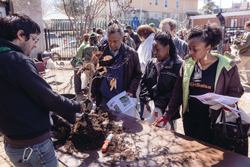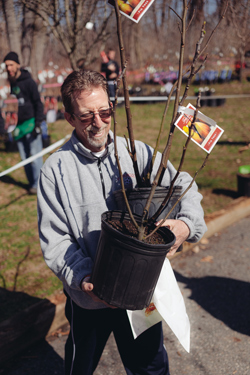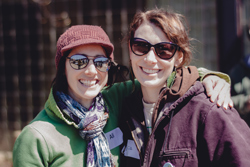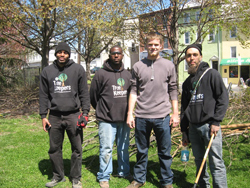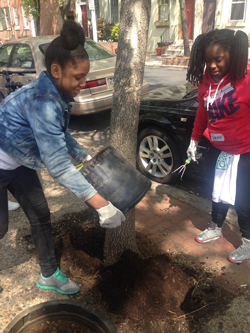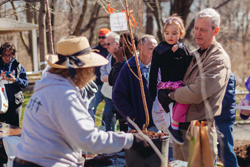by Sara Schwartz
A TreePhilly participant accepts a free yard tree April 6 during the program’s West Oak Lane Library Giveaway.Photo by Charles Bouril
Over the past few centuries, Penn’s Woods have taken a beating. What was once vast forest land as far as the eye could see is mostly pavement today. A 2003 study found that within the five-county Philadelphia region, an estimated five million trees had been lost over the previous 15 years. The most recent study on Philadelphia’s trees, completed in 2010, showed that the region had a tree canopy—the uppermost layer in a forest—of 20 percent, but identified an additional 49 percent (42,451 acres) where trees could be planted.
Now trees are making a comeback. Once-barren streets are seeing plantings, as people remember their incredible value—providing shade, purifying the air, filtering pollution, absorbing noise and strengthening neighborhood connections. Trees have also proven to increase the value of homes.
A collaborative partnership between city agencies, nonprofits and citizens is ushering in change, one tree at a time. TreePhilly, a Philadelphia Parks & Recreation Department initiative, gives away free yard trees to Philadelphia property owners. TreeKeepers, part of TreePhilly, is a seasonal maintenance team that handles a bevy of beautification and park clean-up projects. And Tree Tenders, a Pennsylvania Horticultural Society program, offers hands-on tree-care training, ongoing education and tree-planting opportunities across the region.
Andrew Emma, TreeKeeper’s program manager, shows TreePhilly yard tree recipients at the West Oak Lane Library how to properly plant a container tree.TreePhilly: A Tree of One’s Own
TreePhilly started with some ambitious goals. In 2009 Mayor Michael Nutter released the Greenworks plan, which set a number of sustainability goals, including increasing the tree canopy to 30 percent throughout the city. To reach that goal, Parks & Rec would need to go beyond planting trees on public land; Philadelphia landowners would need to be encouraged to start planting trees, too.
TreePhilly Program Manager Erica Smith Fichman was hired in 2011 as a “generic tree campaign manager” to help figure out what the program should be. “It very much is my baby,” she says of what turned into TreePhilly. The program officially launched in early 2012 by Parks & Rec in partnership with Wells Fargo and the Fairmount Park Conservancy. As of spring 2014, approximately 13,726 trees have been distributed or planted through TreePhilly programs, such as the Yard Tree Program, Street Tree Block Program and other informal plantings and giveaways, including providing trees for Love Your Park events, and creating the recent Arbrew Day event on Arbor Day. That event, a partnership of TreePhilly, Fairmount Park Conservancy and Yards Brewing Company, offered beer specials at five local bars and free yard trees to Philadelphia property owners. One couple left the bar with a tree between them—while riding on their motorcycle. “We were hugely successful,” Smith Fichman says of the event, which ran from 4:30 to 8 p.m. “We gave away all of the trees by 6:30 or 7.”
To apply for a free tree (or two), residents register online, which prompts educational emails, reminders about giveaways and updates from TreePhilly. Smith Fichman says at one recent event up to 350 people signed up, and at another event the line for trees was “maybe a quarter of a mile long.” She adds that the wait doesn’t bother people: “They’re happy to come and wait in line.”
At each giveaway, TreePhilly sets up stations where residents grab information packets and a Wells Fargo swag bag before visiting a table of tree experts who help them choose the right tree for where they live. Smith Fichman says many factors are considered in that decision. Do they want berries or flowers? How big or wide should the tree be? Is there a lot of sun or mostly shade? In addition to giving away larger shade trees, TreePhilly also hands out small flowering trees, and this year, they added fruit trees so people have more options. “Not everyone gets excited about a large shade tree,” she says, laughing. TreePhilly started giving away fruit trees at the Fall 2013 giveaway. The fig trees are especially popular.
TreePhilly partnered with TreeNE and the Friends of Pennypack Park to give away more than 650 trees on April 5 at the Pennypack Environmental Center.Residents can’t register for a specific tree, but when they arrive at a giveaway, they often have a tree in mind, thanks to the educational emails TreePhilly has sent. After a tree type is chosen, volunteers demonstrate how to plant the tree and give residents mulch. Staffers and volunteers package the tree and even help strap it to their car—or to a bike, as one resident did. (A Drexel frat even picked up a tree using their keg trailer.) The education doesn’t end there. TreePhilly follows up to thank you for attending, see whether there are questions and share information on Tree Tender classes.
In addition to giving away free yard trees, TreePhilly signs people up on behalf of the City of Philadelphia to get a street tree planted by contractors. In addition to the City, other partners have rallied around TreePhilly as it greens Philadelphia, including UC Green, an environmental volunteer stewardship in University City and surrounding communities; Philly Tree People, a nonprofit organization that organizes tree plantings in East Kensington, Kensington and Fishtown; and SERVEPhiladelphia, the Mayor’s Office of Civic Engagement and Volunteer Service program. But, like many Parks & Rec programs, TreePhilly is reliant upon volunteers.
Brooke Allen, 38, has been volunteering for two and a half years at the spring and fall tree giveaways. She and her boyfriend, Matt Migliore, are active volunteers at Mifflin Square Park in South Philadelphia, and learned about TreePhilly through the program’s yard tree giveaway there. Allen enjoys working with TreePhilly because the program goes beyond just handing off a tree to a resident.
“You’re getting a tree and you’re getting some education with how to take care of it,” she says. “Other programs will offer you a free tree, but the education behind [TreePhilly]— and even allowing the resident to become part of the decision making to what kind of tree they’re going to get—really offers something special.”
The giveaways have grown so popular that TreePhilly staffers and volunteers have had to turn away walk-ups, Smith Fichman says, adding that staffers instead encourage them to sign up for the next tree giveaway. The popularity of the program is important.
Volunteer Ali Rosenberg and TreePhilly’s Erica Smith Fichman pose at a recent giveaway. “The message is that everyone matters in this,” she says. “Everyone’s slice of property matters and together, we have to work together in order to increase the tree canopy. [The tree is] purifying the air, shading your house, but it’s also providing those benefits to your neighbors—that’s a message that doesn’t get said really often.” She adds that a community coming together to plant trees and helping to green Philadelphia reinforces what TreePhilly is trying to accomplish: “You’re not just doing this for yourself.”
TreeKeepers: Filling the Maintenance Gap
If you’re ever walking along a sidewalk or through a park and an annoying low-hanging tree branch doesn’t thump you on the head, you can probably thank a TreeKeeper. The Parks & Rec program is a part of TreePhilly and aims to train paid workers in all aspects of arboriculture—learning to identify and remove invasive species, improving stormwater infrastructure through maintenance, clearing trails, planting trees and more, including clearing tree branches and overgrowth.
TreeKeepers Josh Burno, Calvin Nixon, Jesse Leary and Jorge Vera take a break while preparing Inn Yard Park in East Falls for Arbor Day festivities. Photo by Cynthia KishinchandTreeKeepers was established in 2011 when Joan Blaustein, the division director of Urban Forestry & Ecosystem Management at Parks & Rec, partnered with the Pennsylvania Horticultural Society to use a Forest Service grant to create the program. After the first year, the program was fully turned over to Parks & Rec, which paired it with TreePhilly to provide a maintenance arm.
Andrew Emma, TreeKeepers’ program manager, has been with the program since the beginning and manages eight full-time crew members and a crew leader. The team works nine months a year (recently increased from six months), April through December, working at the more than 300 parks, recreation centers, playgrounds, health centers, and police and fire stations. The crew has planted trees at schools; assisted TreePhilly with yard tree giveaways; helped to train people enrolled in the environmental stewardship jobs program, Power Corps PHL; taken part in Mayor Nutter’s Arbor Day events; and even worked alongside the Philadelphia Phillies on volunteer excursions. The crew works with Tree Tender groups, volunteers and local park Friends groups to keep parks and green spaces in tip-top shape.
Alice Reiff, who started a Friends group at Inn Yard Park in East Falls in 1998 and has volunteered there since, worked with the TreeKeepers the day before Arbor Day this year, helping to prepare the park for an event. “We needed help [and] they made such a difference in our park,” she says. “The park just looked beautiful. I can’t say enough about them. They were a great group of young men.”
Emma says that in 2013 the TreeKeepers visited more than 40 sites, removing 100 tons of woody plant debris, pruning over 3,000 trees and maintaining “thousands of feet worth” of park trails. He says that while the city plants street trees and yard trees, many of the departments don’t have staff members or resources to keep up with tree maintenance. “There are full-time tree crews who remove the largest trees and limbs, and then the Friends groups who often mulch and do ground-level work,” Emma says. “But there’s no one doing the mid-level work,” so TreeKeepers tries to “fill that gap.”
Students from the Chester A. Arthur School help mulch a street tree for TreePhilly’s Arbor Day event April 25 at Seger Playground. Photo courtesy of TreePhillyEmma says he encourages the crew to undergo Tree Tenders training, “so when they join, they have a little bit of background [and understand] why trees are important.” It’s his aim to retain the crew from year to year so they can expand their base knowledge and set the workers up to be leaders.
Many of the TreeKeepers are ex-offenders, Emma says, which adds an even greater sense of community to the program. When TreeKeepers was created in 2011, it worked with a PHS initiative called Roots to Re-Entry, a 14-week green skills training program that helps inmates in the Philadelphia Prison System find employment in local food production and landscape management upon their release. When TreeKeepers was starting, it was natural to pluck two former inmates from Roots to Re-Entry. While neither are with the program today, Emma says that the program continues to draw ex-offenders.
“It’s something that we take pride in,” Emma says. “It’s a great learning experience for both the ex-offenders and non-offenders to learn more about the diversity in the city and how important job training and re-entry is.”
Tree Tenders: Educate Yourselves, Recruit Your Neighbors
Volunteer Amy Weidner likes to joke that because she’s so invested in greening her neighborhood, she’s been in more people’s houses to talk about trees than for any other reason. “People may know me as the crazy tree lady,” she says, laughing. The energetic mother of four joined the Pennsport Tree Tenders group in 2010. She recently helped to plant 25 trees in the Pennsport neighborhood, and enjoys the sense of community she’s found among neighbors and new friends. “There’s plenty of ways to get involved,” she says. “It’s been a fun way to get to know my neighbors. I’m invested in the city.”
Mindy Maslin, project manager of Tree Tenders of Philadelphia, explains tree maintenance to attendees at TreePhilly’s Northeast Tree Giveaway at the Pennypack Environmental Center in early April. Tree Tenders was born more than 20 years ago out of need. In the ’90s, there weren’t many programs that aimed to plant more trees in Philadelphia. Mindy Maslin, project manager of Tree Tenders of Philadelphia, was hired by the Pennsylvania Horticultural Society in 1991 to manage youth programs, but she began learning about community tree stewardship programs around the country. One in Chicago particularly caught her eye, and spurred her to start a similar program in Philadelphia in 1993 that utilized her background in social work and community organizing. Today, there are more than 4,000 Tree Tenders and 50 Tree Tender neighborhood groups, Maslin says. The program offers hands-on tree care training in the region, and during the nine hours of training, covers tree biology, identification, planting, care and how to work in a community. Tree Tenders planted 850 street trees during the last weekend of April.
“[Tree Tenders] don’t just learn about planting trees; they learn how to recruit their neighbors as well,” Maslin says. “The benefits of trees goes so far beyond what we knew in ’93. … There’s research that shows that tree planting can help to reduce crime in neighborhoods, by just allowing people to have an environment where they want to spend more time outside. People like to go where there’s green.”
To help create those green places that people crave, the Pennsylvania Department of Conservation and Natural Resources (DCNR) launched TreeVitalize, a statewide public/private partnership. That initiative has taken the Tree Tenders training statewide and added 150,000 trees to Pennsylania since 2004. PHS has expanded that mission even further with their Plant One Million Campaign, a three-state, 13-county effort which aims to plant one million trees in southeastern Pennsylvania, New Jersey and Delaware.
Maslin says it’s the largest multi-state tree planting campaign in the country. As of the end of April, “we’re at 300,850,” she says.
To get street trees planted in a neighborhood through Tree Tenders, three residents need to complete training, then submit an application. PHS sends those applications to Parks & Rec, which then picks a species—Maslin says they work with about 45 different varieties—and takes into account overhead wires, sidewalk shape, plant diversity, and whether the tree can handle the challenges of growing in a city, including the onslaught of salt and ice that winter brings. PHS, like many of the other tree planting programs, always aims to plant native trees, but because of climate change, many of those native trees are no longer thriving, so PHS started providing hardier non-native trees with better survival rates, like the ginkgo tree. But it’s not as popular as other species of trees. “When people ask me, ‘How do you get rid of those berries?’ I say, ‘Find a good recipe,’ ” Maslin says, laughing.
Maslin is optimistic about Philadelphia’s future and the number of programs that are helping to add to the city’s tree canopy. “It’s so cool that it’s really taking off like this,” she says. “For years it seemed like it was just the Tree Tender program. The city was pretty horribly underfunded for tree planting and tree care, and now there’s a lot of funding out there and the city is able to do a lot of work it wasn’t able to do before—and that’s amazing.”
story by Sara Schwartz photos by Charles Bouril



